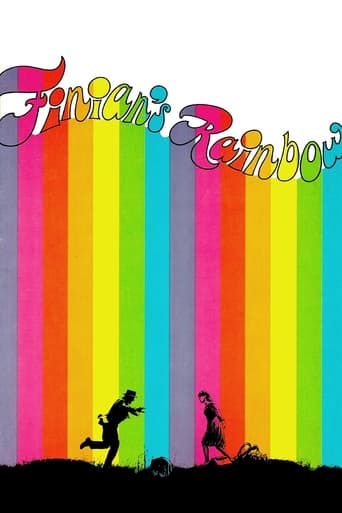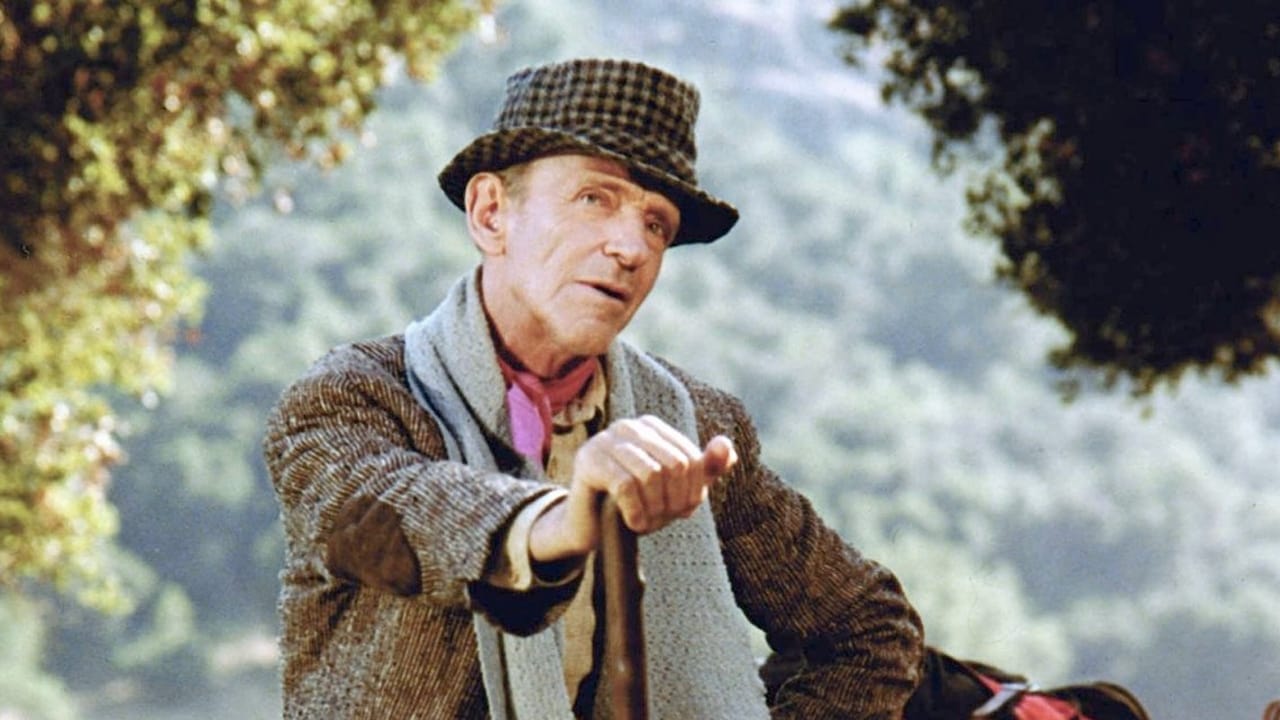bear1955
Too bad about Fred Astaire, in this. Why not have made him Og and gotten someone else for Finian? My take is this well among poorly conceived late-1960s movie musicals. The screenplay is nearly cheerless and un-redeemable because of the integral socioeconomic and racial issues reprised possibly whole, from the late 1940s stage show. Broadway and the West End theatergoers were enthusiastic for the premier runs which both started in 1947. People swooned over the songs. Mentholated-tobacco? Black-face. Heavy-handed stereotyping galore. Irish, southern, and Negro. Tommy Steele being a 'thing'! What were the director (FF Coppola) and producers thinking? Shame about all effort to bring it back as this major movie musical 20-years-plus, later. I've read of several short-run revivals. Read, not heard of. Why ask why.
tavm
While Fred Astaire would dance and sing one more time in That's Entertainment, Part 2, and would give his final acting performance in Ghost Story, in this one would he do all three for the last time. Before I review the movie proper, I have to note that I previously watched this on VHS in a pan-and-scan version that wasn't always flattering. I have now watched a letterboxed version on the Dailymotion site but, unfortunately, the synchronization was often off by several minutes resulting in silence in the last 7. I also watched the last sequence-of several chronological ones uploaded there-on the same site with perfect sync but now it was full screen, the print wasn't as good, and it was interrupted by a commercial. Ugh! Still, despite all that, I managed to mainly understand where certain dialogue exchanges and musical numbers were fit in and highly enjoyed the performances of not only pro Astaire but also Petula Clark, Don Francks, Tommy Steele, Keenan Wynn, Al Freeman, Jr. who does a hilarious spoof of a stereotypical "shufflin' Negro" butler, and Barbara Hancock whose dancing is divine which makes her mostly silent character have a nice personality, among others in the fine cast. Many of Wynn's lines and his changing from white to Negro was quite funny especially since he's not made to look really foolish by doing that appallingly old-fashioned burnt cork appearance of minstrel days but more authentic like though he still looks like a white man pretending to be black. The songs, by E.Y. Harburg and Burton Lane, are fun and romantic and pleasingly sung by the cast. Perhaps the story, a mix of blarney, whimsy, and social satire, dates it in modern times but it's still entertaining enough. And it's wonderful seeing Astaire give it one more try in his old age. So on that note, I recommend Francis Ford Coppola's Finian's Rainbow. P.S. It's interesting to note for "Dallas" fans that two actors that played Digger Barnes were involved in different productions of this musical: Wynn-the second Digger-here and David Wayne-the first one-as Og in the original Broadway version for which he won a Tony. P.P.S. I just finished the other sequence of uploaded videos I mentioned on DailyMotion. Enjoyed it more despite the lesser print, no letterboxing, and the interrupted commercials.
Steffi_P
The 60s were a strange time for cinema – a flourishing of surreal, psychedelic, political and often pretentious film-making. And yet the figures and ideals of the previous generation – Hollywood's golden age – were still around, and neither had they been totally forgotten by the younger generation. Finian's Rainbow was quite literally a remnant from that bygone era, having been an acclaimed stage musical in the 1940s. Had it not been for its controversial subject matter it would probably have been produced for screen in the 50s. As it was, the eventual film adaptation found itself an old-time song-and-dance show in an era where the musical had become something very different indeed.In a way Finian's Rainbow was always a mix-and-match musical. The E.Y. Harburg-Burton Lane score blends Broadway brass with Irish jigs and occasionally gospel to surprising success. The story also places old-world folklore alongside contemporary racial issues, in what is a sometimes awkward but generally passable modern-day fairytale. Aside from anything else, the Lane melodies are of considerable beauty and the Harburg lyrics witty enough that it makes a broadly appealing and timeless package. Fans of the inventive wordplay in the numbers from Wizard of Oz, which were also penned by Harburg, will appreciate such clever twists as "Make him a better person
not a worse 'un" Harburg even reuses the word "individdle", here rhyming it with fiddle, having rhymed it with riddle in Oz.Another relic of the old days appears in the form of Fred Astaire as the titular Finian. Astaire may be lacking his cane and topper, he may be showing the signs of his age a little, and his accent may be about as authentically Irish as a gift-shop Shillelagh – but it's still the same old Fred, full of the effortless dance-steps and easygoing charm that won over audiences thirty-five years earlier. It's a real delight to see him here, partly because his endearing demeanour is so reassuringly familiar, and yet he still makes an honest attempt to deviate from his regular persona to create this crusty yet lovable old Irishman. Representing the new is a fresh-faced Tommy Steele, playing the leprechaun Og. A certain proportion of Steele's performance, say 10%, is pure brilliance. Unfortunately the remaining 90% is pure annoyance, as Steele grins and capers his way maddeningly through some disappointingly flat renditions of the Harburg-Lane numbers. Still, he does appear to have struck some kind of unlikely rapport with Astaire, and their scenes together are among the most brightly comical.The director was from the young side of the fence. Francis Ford Coppola was a graduate of Roger Corman's schlock factory, and this was his first big-budget assignment. Coppola had already demonstrated himself to be a director who took a detached and distant view of things, often keeping his camera high above the action or peeping from amongst foreground foliage. Oddly enough this sets him up well for the light and abstract world of the musical, in which the broad canvas, rich detail and ensemble are more important than the intense close-up or the dramatic long take. Coppola shows real sensitivity to the music, keeping rhythms going with natural-looking background movement – check out the way the crowd shifts behind Petula Clark and Don Francks during "Look to the Rainbow". He also uses his harmonious technique to draw attention to the lyrics, for example having the camera pan up to the heavens on the line "Skies could be so bluish blue" in "Something Sort of Grandish".The conventions of the time and the sensibilities of the young production team have certainly left their mark on Finian's Rainbow. There are many thinly-veiled references to hippy and protest culture, with the "tobacco"-growing enterprise, a business-like police force and even a sit-down, in a reasonable attempt to make this a musical equivalent of In the Heat of the Night. However the difference between the old and the new is too stark for them to fuse. Coppola's penchant for realism results in some stunning outdoor photography, but this only grates all the more with the woefully fake-looking studio "forest", the like of which would now only be seen in a kid's TV show. Most of the components are glorious, but as a whole it is occasionally like watching two separate films spliced together.However, Finian's Rainbow is at least self-aware enough to realise that it has the opportunity to be a respectful homage to the classic musical, and never descends into a roughshod "update". The most profound and emotionally stirring aspect of the picture is that Astaire evidently knew it would be his last appearance as a dancer. Coppola surely knew it too, and the tender staging of Astaire's final scene is among the most poignant moments of self-reference in movie history.
aimless-46
"Finian's Rainbow" (1968) is one of the few films I saw three times in the theater, and since repeat viewings are normally not my thing it must have made some connection or maybe I just enjoyed watching Barbara Hancock dance. Despite this I agree with most of the critical comments about portions of the film.Unfortunately it was assembled as a 145 minute "roadshow" musical; these were overlong spectaculars which depended less on the charm of the performers (think 1930's) than on pre-sold event marketing (unnecessary, pretentious, overscale, and distracting production values; souvenir programs; etc.). Right around the time of its release these mega-productions were leading many of the studios to financial ruin. Warner Brothers took a hit from this one; box office was bad but fortunately Coppola worked cheap and had cranked this out on the back-lot with a relatively modest budget.Trim about 30 minutes from the film and you would have a much better production. There is a lot of stuff here that is supposed to be fun and just doesn't make it. Fortunately there are some real gems sandwiched throughout the film.Think bi-racial "Lil Abner" (1959) with a touch of "The Wizard of Oz" (1939). The Oz connection comes from lyricist E. Y. Harburg, the guy who gave us "If I Were the King of the Forest". There are enough such silly songs to make up for toughing out the musical clunker moments. Tommy Steele absolutely shines doing this material (insert Bert Lahr here) .Nothing wrong with the performances of Fred Astaire or Petula Clark either. And its not just his dancing and her singing, they both achieve excellent characterizations. Astaire at 70 does not look much different facially than Astaire at 30. But this time instead of a physically unlikely love interest he plays a warm old man still chasing a dream, and it's a much better fit. Clark does an excellent Debbie Reynolds and more than holds her own through the production.Unfortunately there is little good to say about the casting of Don Francks as Petula's love interest and Hancock's older brother. Most likely Coppola felt that the film needed a relatively hip looking guy in place of a Gordon MacRae type. But Francks comes off as more of an oily hotshot; the kind of guy who would proposition your 14 year-old sister.The plot has Finian and his daughter coming to Kentucky to bury a crock of gold he has stolen from a leprechaun back in Ireland. Finian believes that he can produce some kind of synergy by getting the gold within close range of Ft. Knox. They end up in a racially mixed Dogpatch named Rainbow Valley, where blacks and whites work side-by-side as tobacco sharecroppers. There is considerable intrigue involving the local racist political hacks, a new strain of mentholated tobacco being developed by a George Washington Carver type (nicely played by Al Freeman Jr.), back taxes on the sharecropping collective, romance, and a leprechaun who is slowly becoming human.Barbara Hancock, a young but quite accomplished ballet dancer, is fetching as "Susan the Silent" (who dances instead of talking). Coppola adds a lot of nice lyrical moments by showcasing her dancing. It is said that Astaire resented her being cast instead of an older dancer he recommended. They are not paired in any number, a failure conspicuous by its absence.The widescreen DVD looks great and the Coppola commentary is surprisingly interesting.Then again, what do I know? I'm only a child.



 AD
AD




